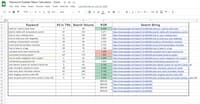Internal links are one of the most important technical SEO factors that can make or break your search engine rankings. Linking between pages on your own website provides tremendous SEO benefits that can help pages gain relevance, authority, and discoverability in search engines like Google. According to experts at Niche Site Project, internal links are key for increasing traffic.
In this post, I’ll explain everything you need to know about crafting an optimal internal linking structure to boost your site’s SEO.
What Are Internal Links?
Internal links are hyperlinks that connect from one page on a website to another page on the same domain. For example, if you have blog posts that link to your service pages, contact page, or category archives, those are internal links.
External links point users to outside websites. Internal links keep users on your site by linking them through to more of your content.
Crafting an effective internal linking strategy takes thought and precision, but it’s worth the effort. Optimized internal linking helps with:
- Passing page authority and anchor text
- Helping pages get indexed
- Creating a better user experience
- Consolidating the power of your best pages
Let’s explore why internal links are so critical for SEO success and how to strategically build them.
Why Internal Links Matter for SEO
Passing Page Authority and Anchor Text
Each page on your site has its own authority and value. Internal links allow you to pass authority, anchor text, and link equity from one page to another.
For example, linking from an authoritative pillar page like your Homepage to an important blog article will pass some of that homepage power on to the blog post. Optimizing those links with anchor text using your target keywords will also give that term more influence.
This helps search engines understand the relevance of the connected pages for those keywords. Done well, internal linking makes pages stronger both individually and collectively.
Helping Pages Get Indexed
Internal links also help search bots discover new and existing content on your site to get indexed in search engines. Crawlers follow the links to find pages, rather than needing everything linked off the homepage.
This means you can create clusters of content with internal links between them. The pages support each other in gaining indexation without weighing everything on your homepage.
Creating a Better User Experience
Internal site links allow users to naturally navigate and explore your content. Clickable links in your articles that go to related posts or relevant category pages keep users engaged.
This improves time on site metrics and reduces bounce rates. Users who click through many pages tend to convert at a higher rate too.
Consolidating Page Authority
Carefully planned internal links focus linking power on pages you want to rank well. This prevents dilution of authority by consolidating it to your most important pages.
For example, linking all blog posts to your Best Posts page or Most Popular page gives extra authority to that page as a hub. The other pages still get a boost too.
Now that you know why internal links matter for SEO, let’s get into how to build them effectively.
Best Practices for Internal Link Building
Here are some best practices to follow when creating internal links between the pages on your website:
Identify Pillar Pages and Content Clusters
Determine which pages you want to be the super-strength pillars that support rankings for your priority keywords and topics. Also look for clusters of content around subtopics to link together.
For an ecommerce site, pillars may include the homepage, product category pages, shopping cart, etc. For an informational site, key pages could be the About page, popular blog posts, service pages.
Link these pillars together and to related content clusters through contextual internal links. The pillars will consolidate authority.
Use Relevant Anchor Text
When linking internally, use descriptive anchor text with keywords where it fits contextually. This passes specific relevancy signals. However, avoid aggressive over-optimization with exact-match anchor text on every link. That can seem spammy.
The anchor text you use for internal links helps indicate to search engines what the page you’re linking to is about. Use keywords appropriately.
Link to Deep Pages
Don’t just link from site-wide navigation or the homepage. Add internal links within content to pass authority to deeper pages on your site too.
This allows for more of your site to get indexed by facilitating crawler discoverability. Vary how you link to deep pages for a natural flow.
Vary Link Placement
Add internal links throughout your content in different places, not just once below each post. Put some in the intro paragraph, middle, conclusion, etc. Even link within a paragraph if it fits the context.
This feels more natural to users and search engines versus cramming links together. Varying placement also helps avoid a layout where one section always links.
Audit and Link to Orphaned Pages
Conduct an audit to find any “orphaned” pages that have no internal links pointing to them. Adding links can help these get indexed.
Try to ensure all pages have at least one internal link, though pages with the most useful content will naturally attract more links. Proactively link out to forgotten pages.
Use Contextual Links
Internal links should flow naturally within the content and context. Don’t force in links just for SEO. Make sure they make sense for users too.
For example, mention a study on a topic, then link to the page where you explain that research more. The context supports why the internal link exists.
Link to Related Resources
Look for opportunities to cross-link out to related content across your site. When mentioning a related concept, service, product, or idea, link out to pages where you expand on it further.
This builds a web of useful internal connections between pages on related topics so they support each other in search.
Utilize Menus and Navigation
Pay attention to site menus and navigation elements. Ensure your category pages and top level site pages link to and from each other from the main navigation.
These major site sections should have clear connections to pass link equity and prominence. Don’t keep them isolated.
Implement Site Search
Add a site search feature that allows visitors to search for pages and content on your site. When they click results to those internal pages, it creates link flows.
You can also monitor site search queries and link to pages from your content based on what people commonly search for.
Link Images and Graphics
When you have images or other media in your content, use descriptive alt text and link those assets to the pages on your site where you discuss them further.
Don’t just link to the image file itself. Send those image links to contextual content pages for optimal SEO.
Link Within Page Architecture
Pay attention to page layout within content. Use content tabs, side menus, or spacers with related links to allow internal linking to other sub-sections.
For long pages or sections, add jump links to allow quick navigation further into the page using internal anchors.
Create Breadcrumb Trails
Use breadcrumb trails under page titles or sections to show site hierarchy and taxonomy. Each breadcrumb is an internal link, typically to that content category or tag archive page.
This provides context and more internal link opportunities. Just keep breadcrumbs clean and compact.
Link Within Paragraphs
Don’t relegate internal links only to a “Related links” section. Flow them naturally within paragraphs as you link to various related resources.
Work them conversationally into the content so they seem editorial. But avoid linking every paragraph or sentence.
Use Internal Site Search
Leverage your analytics to see what users commonly search for on your internal site search. If you notice they search for a certain topic a lot, consider linking to that content from other relevant pages proactively.
You can discover linking opportunities from your internal search data.
Check Competitor’s Internal Links
Research competitors’ sites and see where they implement internal links between pages. Don’t copy them directly, but their linking strategies may spark good ideas.
See what types of pages they interlink related to sections you also have. Use it as inspiration but tailor to your site architecture.
Technical Tips for Internal Link Optimization
On the technical side, also keep these internal link best practices in mind:
Use Relative Links
Where possible, use relative link paths in your site’s code, rather than full URLs with the domain. e.g. /blog/category/ instead of https://www.yourdomain.com/blog/category/
This helps avoid broken links if you change domain names or page URLs. Relative links still work as the site changes on the backend.
Link to Supporting Assets
When linking out to assets like PDFs, videos, images or downloads, include contextual text around the link explaining what it is. Don’t just have bare links to downloads.
This provides a descriptive reason for the link to that asset, which is useful for both users and SEO.
Add Linking Schema Markup
For internal links between highly related pages like “Part 1” and “Part 2” of a series, use schema.org markup to designate the connection. This helps search bots understand the relationship.
For example, use <a itemprop=”url” href=”page2″> for internal series links.
Implement XML Sitemaps
Having an XML sitemap listing all pages helps search bots discover new content, including internal pages. Ensure your sitemap contains all interconnected internal links too.
This facilitates indexation of your important linked internal pages that search engines may otherwise miss.
Check for Crawl Errors
In Google Search Console, look for any crawl errors related to internal links, like “Page Not Found” or blocking by noindex tags. Fix anything limiting bots’ ability to follow internal links.
Descriptive Anchor Text
Use brief but descriptive anchor text with your internal links where possible. For example, instead of “click here”, use “internal site search page”.
Summarize what the page you are linking to is about.
Link to Quality, Useful Content
Avoid linking internally to lower quality pages with thin content just for the sake of adding links. Focus on interlinking robust, useful content instead.
Search engines want sites linking to pages that offer true value to visitors.
Avoid Excessive Internal Links
There can be too much of a good thing. Don’t go overboard trying to internally link every page from everywhere. Moderation is key.
If you over-optimize with links everywhere, it can raise spam flags. Keep it reasonable.
Keep Access Restrictions in Mind
Remember that links to pages blocked by login access or with other restrictions might not pass full SEO value. Search bots can’t access restricted content.
Also, noindexed or missing pages won’t pass value either. Double check you aren’t linking to these.
Monitor Indexation Regularly
Log into Google Search Console to monitor your site’s indexation over time. Check that your important internal linked pages, including deeper pages, are getting picked up.
Pages that should be indexed but aren’t may have an underlying issue with crawling or discovery.
Use Nofollow Sparingly
Avoid slapping nofollow on all internal links. This can limit their power. Only use nofollow attributes when you specifically want to limit passing equity for certain links.
Like outbound links to untrusted sites. Don’t blanket nofollow all internal links without reason.
Measuring and Monitoring Your Internal Linking Strategy
Here are some ways to measure and monitor the success of your internal linking strategy:
Check Indexing and Crawl Stats
Monitor your site’s crawl stats and indexation rate in Google Search Console. Internal links should help get pages discovered and crawled.
Look for improvements in pages indexed as you optimize internal linking structure.
Monitor Rankings Changes
Track keyword ranking positions over time, especially for keywords you strategically optimized internal links around. Look for positive movement.
Internal links alone may not lead to massive jumps, but can impact incremental improvements.
Review Site Architecture
Periodically review your site’s information architecture and ensure your categories and subsections allow for natural internal linking between topics.
Refine site structure if needed to support intuitive internal connections.
Update Broken Links
Check for any broken internal links leading to 404s or unavailable pages. Fix or remove these immediately to maintain the flow of equity to other pages. Don’t let your internal network decay.
Key Takeaways
To recap, here are some key takeaways:
- Internal linking is hugely influential for SEO in terms of passing authority, improving page relevance, and facilitating discovery and indexation.
- Be intentional with what pages you interlink and the anchor text you use. But avoid excessive optimization.
- Consider both semantic structure and ranking priorities when linking internally.
- Use relative links and descriptive anchor text for optimal technical SEO.
- Monitor your internal linking strategy and refine it continuously for better crawling and conversions.
Well-executed internal links provide the glue that holds your site together and helps it excel in search. By following these tips and best practices, you can craft an internal link structure tailored for long-term SEO success.
Conclusion
Internal links form the SEO foundation upon which your website is built. A thoughtful internal linking strategy distributes authority across your site, connects related content, improves page discovery, and enhances the user experience.
While search engines have cracked down on aggressive link schemes, organic internal linking remains a legitimate and powerful ranking signal. When optimized properly with the right technical elements in place, internal links can take your SEO results to the next level.
I hope this guide gave you a comprehensive overview of the immense impact internal links have for on-page SEO and site discoverability.



